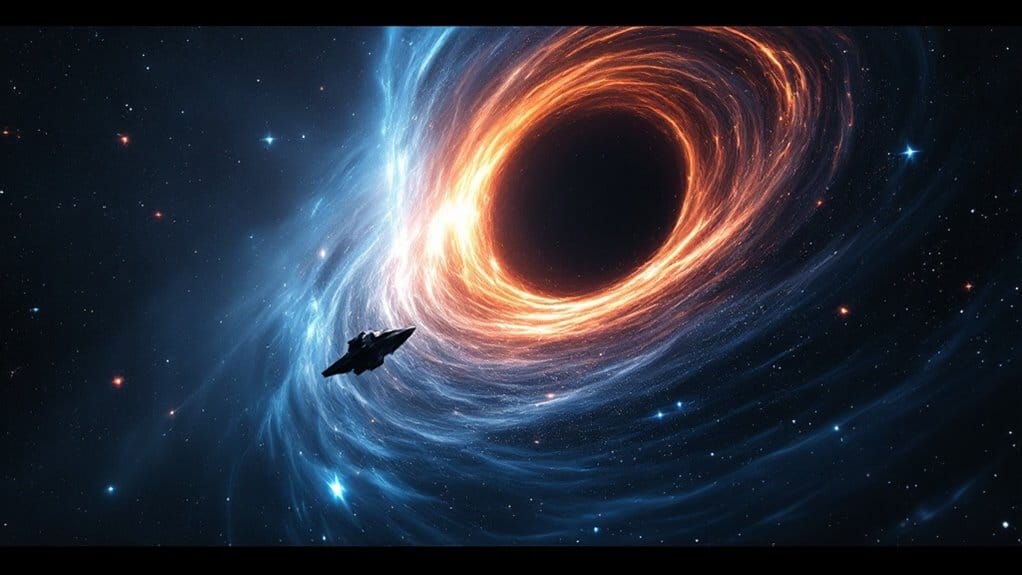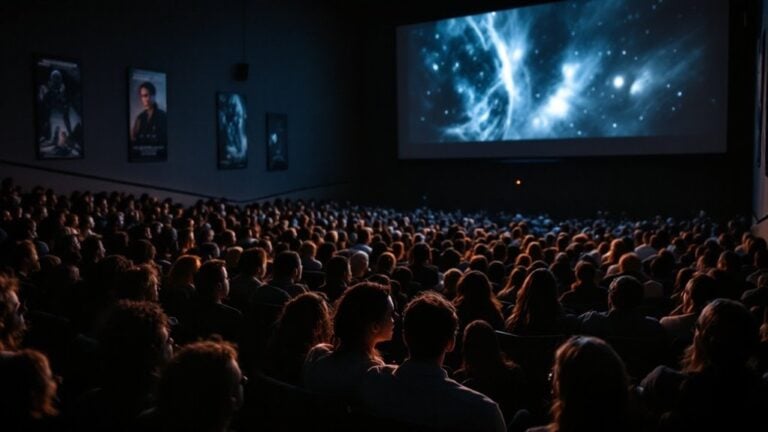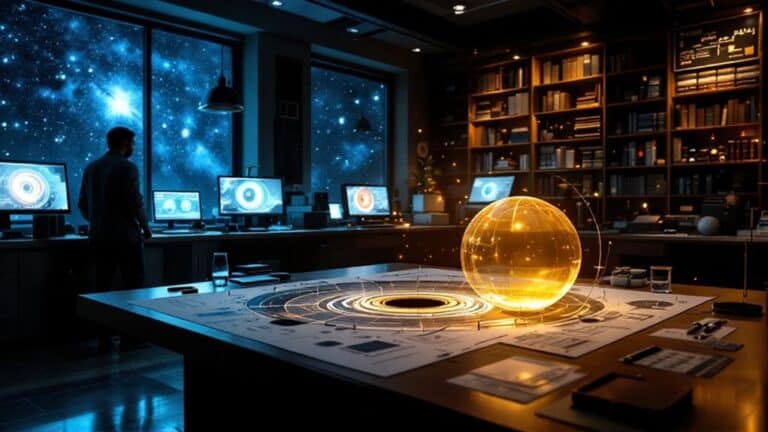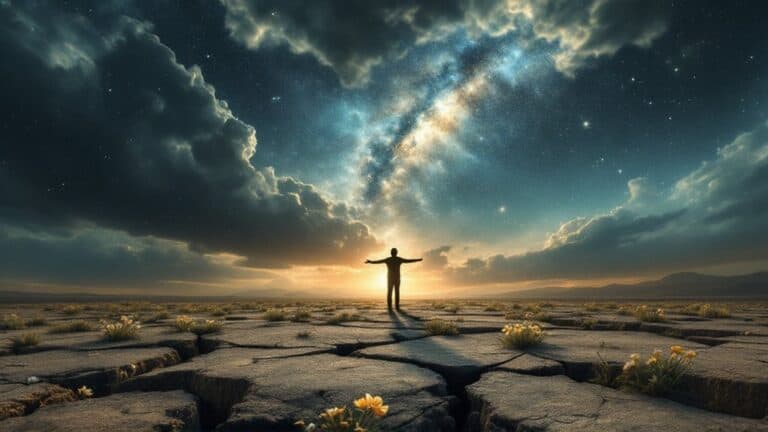The Art of Visual Storytelling: How Interstellar Redefined Sci-Fi Cinematography
Interstellar redefined sci-fi cinematography by merging innovative techniques with deep emotional narratives. You can see how the use of IMAX cameras creates stunning visuals, capturing both the vastness of space and intimate character moments. Grounded in scientific accuracy, the film’s portrayal of black holes and time dilation resonates with real physics. Cinematographic choices, like handheld shots and shallow depth of field, heighten emotional connections, inviting you to explore humanity’s struggles. Its homage to cinematic classics and practical effects fosters realism, inspiring future filmmakers to push visual storytelling boundaries. There’s much more to uncover about this cinematic masterpiece.
Table of Contents
Key Takeaways
- “Interstellar” employed IMAX cameras for stunning visual clarity, enhancing both the vastness of space and intimate character moments.
- Innovative lighting and shallow depth of field amplified emotional resonance, deepening viewer engagement with character interactions.
- Accurate scientific depictions, like black holes and time dilation, established a new benchmark for realism in visual effects within sci-fi cinema.
- The film’s narrative structure blended grand themes with personal stories, redefining character development and emotional depth in storytelling.
- Influenced by cinematic classics, “Interstellar” fostered a renewed interest in sci-fi, inspiring filmmakers to prioritize authenticity and visual realism in future projects.
Cinematography Techniques
Cinematography techniques in “Interstellar” play an essential role in immersing you in its vast universe. The film employs a variety of camera movement and composition techniques that enhance its emotional depth and visual storytelling.
For instance, the use of IMAX cameras captures breathtaking, expansive images of space while also drawing attention to the subtle expressions of the characters. This dual focus allows you to feel both the enormity of the cosmos and the intimacy of human experience. Notably, the film was partially filmed in IMAX, which enhances the immersive experience for viewers. Moreover, the film’s collaboration with experts ensured a scientifically accurate portrayal of phenomena like black holes, further enriching the visual experience. Additionally, Hoyte van Hoytema’s signature style of shallow depth of field amplifies the emotional resonance of character interactions, allowing their struggles to take center stage.
Handheld shots create a sense of instability on Earth, reflecting the struggles faced by the characters. Alternating between kinetic and steady shots mirrors the film’s emotional rhythm, pulling you into the high-stakes moments.
Large-format film stock adds a tactile, organic texture, making every scene feel grounded and real. Additionally, careful blocking and composition techniques create claustrophobic moments that heighten tension, while sweeping shots evoke a sense of awe.
The stillness captured by IMAX cameras contrasts with the chaos of critical scenes, allowing you to absorb the weight of each moment. Together, these techniques redefine visual storytelling in sci-fi, inviting you to explore both the vastness of space and the depths of human emotion.
Scientific Accuracy
Frequently, science fiction films struggle to balance entertainment with scientific accuracy, but “Interstellar” stands out for its commitment to realistic portrayals of complex astrophysical concepts. The movie’s black hole depiction mirrors actual images from the Event Horizon Telescope, showcasing a stunning three-dimensional spherical look that captures the intense gravitational distortion.
With guidance from physicist Kip Thorne, the film’s team created groundbreaking software to illustrate gravitational lensing, a feat later validated by real-world observations. This innovation reflects Thorne’s collaboration with filmmakers, ensuring that the visual representation of Gargantua aligns closely with theoretical physics. Additionally, the team consulted with former astronaut Marsha Irvins to enhance the film’s authenticity.
Equally impressive is the accurate time dilation portrayal, rooted in Einstein’s General Relativity. You see how time slows near massive celestial bodies, particularly black holes, which adds a layer of emotional weight to the story. As the characters grapple with these gravitational differences, you can feel the tension that arises from their choices, emphasizing the real consequences of their proximity to such forces. Moreover, the portrayal of the black hole Gargantua resembles real-life images captured later, showcasing unprecedented accuracy in cosmic visualization.
Astrophysicists, including Neil deGrasse Tyson, have praised how “Interstellar” represents these complex scientific principles, elevating the film beyond mere entertainment. By weaving accurate science into the narrative, it creates a deeper connection with viewers, making you reflect on the mysteries of the universe and our place within it.
Visual Effects

Visual effects play an essential role in shaping the immersive experience of “Interstellar.” The film masterfully combines practical effects with cutting-edge digital techniques to create stunning visuals that enhance the storytelling. Through these visual innovations, you’re drawn into a world that feels both real and fantastical. Additionally, the film’s collaboration with astrophysicist Kip Thorne ensured that the depiction of black holes was grounded in scientific accuracy, further enhancing the credibility of the visuals.
Here are three standout techniques that showcase this visual realism:
- Projection Techniques: Giant screens were used to project dynamic backgrounds, creating environments that feel alive.
- Practical Ship Models: Full-size models, combined with hydraulic systems, offer you a tactile experience of space travel. Additionally, Nolan’s approach to realism ensures that these practical effects resonate with viewers on a deeper level.
- Advanced Rendering: A new renderer accurately depicts black holes, pushing the boundaries of technological innovation. Joey Shanks’ techniques in recreating the black hole effect also emphasize the importance of practical effects in modern filmmaking.
Inspirations and Influences
The rich tapestry of inspirations and influences behind “Interstellar” weaves together classic filmmaking techniques and scientific authenticity. You can see the echoes of Andrei Tarkovsky’s work, especially his films like “Solaris” and “The Mirror,” which inspire the use of natural elements like fire and wind throughout the film. These Tarkovsky influences lend “Interstellar” a lyrical quality, inviting you to reflect on the emotional weight of its journey.
The deliberate pacing and sweeping compositions pay classic homage to cinematic greats like “2001: A Space Odyssey,” melding realism with speculation. Moreover, Christopher Nolan’s commitment to practical effects and shooting in real locations, like Iceland for the ice planet scenes, enhances the film’s authenticity. By incorporating real NASA footage and collaborating with scientists, “Interstellar” grounds its visual storytelling in scientific accuracy, making it resonate deeply with audiences. The choice of large-format IMAX cinematography elevates the immersive experience, allowing viewers to feel both the enormity of space and the intimacy of human connection. Additionally, the film’s emphasis on practical effects over CGI further enriches its visual narrative and establishes a tangible connection to the universe it depicts. Hoyte Van Hoytema’s collaboration with Nolan emphasized fresh visual perspectives that contribute to the film’s unique aesthetic.
The use of large-format IMAX cameras captures both the vastness of space and intimate character moments, bridging the gap between the grand and the personal. This intricate blend of influences not only creates a visually stunning experience but also invites you into a profound exploration of humanity’s place in the cosmos.
Impact on Sci-Fi Cinema
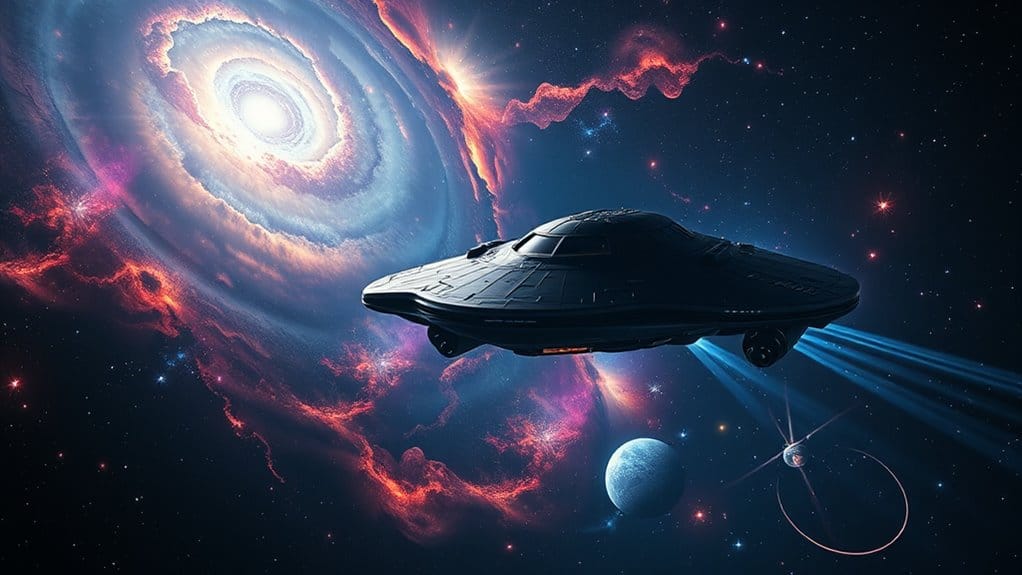
Building on its rich inspirations, *Interstellar* has left a profound mark on sci-fi cinema, redefining standards for visual effects and storytelling.
Its innovative approach to character development and narrative structure hasn’t only captivated audiences but also influenced filmmakers across the genre. Here are three significant impacts:
- Visual Realism: The film’s groundbreaking CGI and practical effects created a level of realism that set new benchmarks, inspiring future projects to aim for similar authenticity. *Interstellar* was particularly praised for its scientific accuracy, especially in its depiction of black holes. This commitment to realism, alongside its collaboration with theoretical physicist Kip Thorne, set it apart from other sci-fi films of its time.
- Standalone Success: By proving that standalone films could thrive, *Interstellar* encouraged studios to invest in high-concept storytelling, allowing filmmakers the freedom to explore complex narratives without the pressure of sequels.
- Cinematic Techniques: The use of IMAX cameras and innovative lighting techniques elevated the emotional depth of the film, engaging viewers in a visceral experience that resonates beyond the screen.
Ultimately, *Interstellar* has reshaped the landscape of sci-fi cinema, marrying stunning visuals with profound themes.
Its legacy continues to inspire a sense of belonging for cinephiles and creators alike, reminding us all of the power of storytelling to connect, challenge, and transform.
Conclusion
To sum up, “Interstellar” isn’t just a film; it’s a masterclass in visual storytelling that reshapes our understanding of science fiction. By blending breathtaking cinematography, meticulous scientific accuracy, and innovative visual effects, it inspires filmmakers and audiences alike. It challenges us to ponder the vastness of space and the depths of human emotion. Ultimately, “Interstellar” elevates the genre, leaving an indelible mark on cinema and inviting us to dream bigger and think deeper about our universe.

